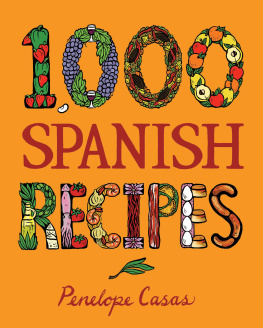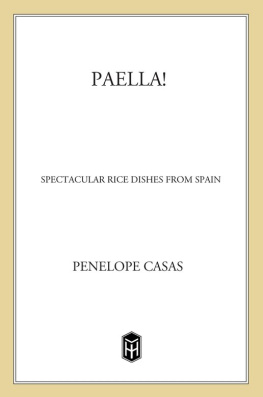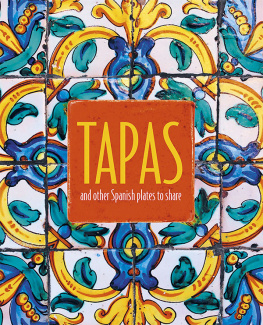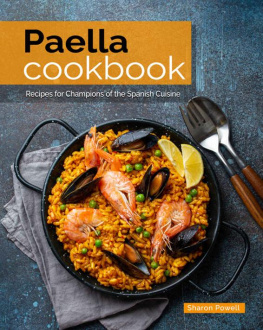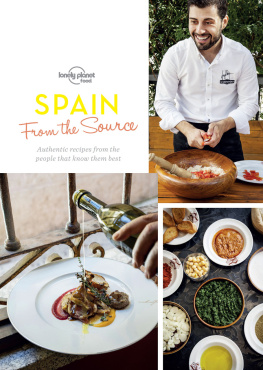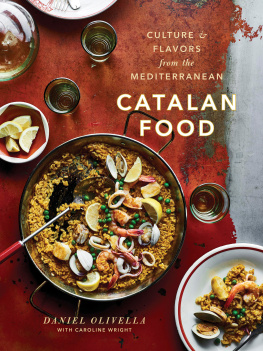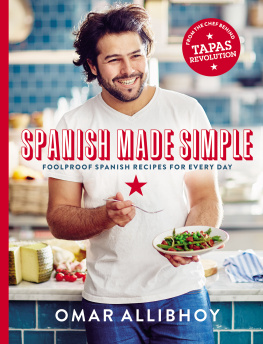Skewered Bites (Banderillas)
V
V
V
V
Marinated and Pickled Dishes
V
Cooked Shellfish
Cooked Fish, Squid, and Octopus
Cooked Vegetables
V
V
V
V
V
V
V
V
V
Cooked Meat Dishes
Croquettes and Fried Pastries
V
V
V
V
V
V
V
V
V
V
Mini Turnovers (Empanadillas)
Canaps and Pts
V
V
V
V
V
V
V
V
V
V
V
V
T apas, the little dishes of Spain, are the most representative foods in Spanish cuisine. Any food can be a tapa, but the main characteristics are that tapas should be served in small portions, served promptly in a pleasant, friendly environment, and be affordable. In Spain, tapas bars are plentiful and offer both traditional dishes and regional cuisine. Tapas from the Mediterranean shoreline are quite different from those from Castile or those from Galicia, in the north. The variations are infinite, and traveling is the best way to get acquainted with all that tapas have to offer.
But going out for tapas (or as Spaniards say, ir de tapeo) is not just a way of eating. Its a way of life. Spaniards love tapas bars because they can mingle in convivial surroundings and converse about politics, gossip, sports, and bullfighting. They do this while drinking wine or beer and sharing tapas with each other. Tapas bars allow people to communicate, socialize, and relax after work with family, friends, and co-workers. Having a drink and something delicious to eat just makes it a more enjoyable environment.
For many years tapas have been a staple of Spanish gastronomy, and much has been written about their origin. Even though tapas can be found in every region of Spain, its beginnings can be traced to Andaluca and principally to Sevilla, known for its warm climate, friendly people, and slow-paced atmosphere. Literally translated, tapa means lid or cover. Traditionally, when a glass of sherry or wine was served, a small tapa, such as a slice of chorizo or cheese or a small dish with olives, was placed on top of the glass. The tapa was usually complimentary and served as an incentive for the client to purchase another drink.
Tapas are varied, usually based in the cooking of the regions where the bars are located. They can be very simple, such as slices of ham, chorizo, or cheese, or a small plate of almonds or olives, or they can be more elaborate, involving sophisticated sauces such as mayonnaise, vinaigrette, or romesco, a pepper-based sauce. In different regions, tapas have their own character and even a unique name, such as in the Basque provinces where tapas are known as pinchos and consist frequently of a toothpick skewering different ingredients or a simple slice of bread with something on top of it.
In the past few years, modern tapas bars have opened all over Spain, and tapas have become quite sophisticated due to the influence of several inventive chefs such as Juan Mari Arzak and Ferran Adri. Innovative and creative techniques have taken tapas to a new level: La Nueva Cocina, or Spains new cuisine, has taken the gourmet world by storm.
Throughout the years, I have served tapas in my house to family and friends instead of a formal dinner. At my tapas parties, friends can serve themselves from the many dishes available, sit where they please, and mingle with one another freely. I strongly recommend serving tapas when entertaining.
Skewered Bites (Banderillas)
V
V
V
V
Banderillas are a separate class of tapas, consisting of marinated fish, meat, olives, vegetables, and other ingredients skewered together with a toothpick. They are very easy to prepare, and you can mix and match any ingredients you want to create different taste sensations. It is important that you put everything on the toothpick in your mouth at once so the flavors will blend. Banderillas derived their name from their resemblance to the colorful, ornamental darts used in bullfighting.
Sample Banderillas
Makes 1 tapa
Here are four examples of typical Spanish banderillas simple bite-size ingredient stacks to serve with drinks or at parties, usually skewered on toothpicks. Ingredients can be added or omitted according to personal preference. Each combination creates a different taste. Experiment to see which you like best.
- 1 pitted green olive (with or without pimiento), preferably Spanish
- One (-inch) crosswise slice dill or cornichon pickle
- One (-inch) piece (jarred) piquillo pepper or pimiento
- One (-inch) chunk canned or jarred white or light meat tuna, drained
- 1 cooked shrimp, shelled and deveined
- One (2-inch) cooked asparagus tip
- , to taste
- 1 wedge small hard-boiled egg
- 1 rolled anchovy fillet, with or without capers
- 1 pitted black olive, preferably Spanish
- , to taste
- small hard-boiled egg, cut crosswise and trimmed at the bottom to sit flat
- 1 small cooked shrimp, shelled and deveined
- One (-inch) square piece Serrano (Spanish cured mountain) ham or prosciutto, cut from a slice inch thick
- , to taste
- Parsley, for garnish
For each of these tapas, add the ingredients to a skewer in the order they are listed and garnish as directed. Increase the ingredient amounts for the number of tapas you want to serve. They are usually served at room temperature.
Banderilla Dressing V
Picada
Makes enough to dress 20 banderillas
The recipe for this picada sauce comes from Tito of the Bar Cascabel in Madrid, which specializes in banderillas . Picada a finely chopped mixture of garlic, parsley, pickle, and oil adds an interesting flavor to just about any banderilla you can think of. Picada sauce should be made in a food processor and processed until as smooth as possible.
- 3 tablespoons finely chopped fresh flat-leaf parsley
- 3 garlic cloves, finely chopped
- 2 tablespoons dill or cornichon pickle, finely chopped
- 3 tablespoons olive oil
Place the parsley, garlic, and pickle in a food processor and process until smooth. With the motor running, gradually add the oil. Process until as smooth as possible. Serve at room temperature, or store up to 5 days in a covered container in the refrigerator and bring to room temperature to serve.
Black Olives Marinated in Paprika V
Aceitunas Negras con Mojo
Makes 6 to 8 servings
Though most Spanish olives that find their way to the United States are green, black olives are more frequently used for tapas in Spain. This well-seasoned marinade enhances their flavor with a recipe that calls for cumin, reflecting a Moorish influence.
Prepare at Least 10 Days in Advance
- One (7-ounce) jar black olives, preferably Spanish, drained
- 5 garlic cloves, lightly smashed
- teaspoon ground hot paprika, such as Spanish smoked
- 1 tablespoon ground bittersweet paprika, such as Spanish smoked
- 1 teaspoon dried oregano
- 2 sprigs thyme
- teaspoon ground cumin
- One (2-inch) strip orange peel (orange part only)
- 2 sprigs parsley
- 2 tablespoons extra-virgin olive oil

